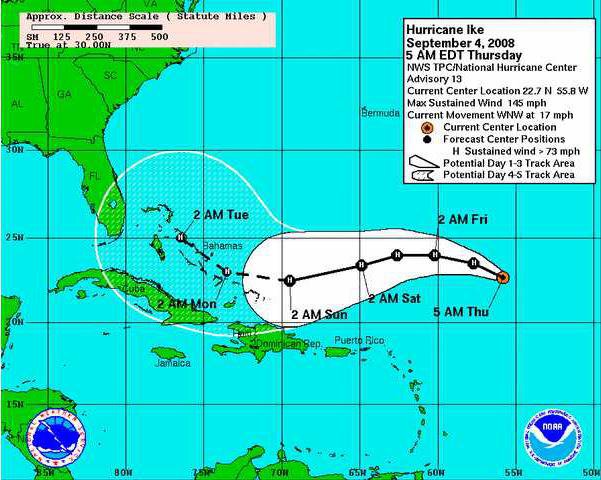NASSAU, Bahamas -- While officials from Nassau to South Carolina were keeping an eye on Tropical Storm Hanna, behind it, Hurricane Ike was gaining strength as it lumbered across the Atlantic as a powerful Category 4 storm.
Hanna was just east of the Bahamas and heading northwest early Thursday, a day after knocking out power to the southern Bahamas.
In the United States, a hurricane watch was issued for the area from Edisto Beach, S.C., north to Surf City, N.C. And a tropical storm watch was issued for Edisto Beach and south to Altamaha Sound, Ga. A hurricane watch means hurricane conditions are possible within 36 hours. A tropical storm watch means tropical storm conditions are possible within 36 hours.
Hanna's winds increased to 70 mph (110 kph) Thursday. The tropical storm turned to the northwest Wednesday after lingering for days near Haiti, where it caused flooding that killed 26 people.
Bahamas National Security Minister Tommy Turnquest canceled all leave for the Bahamas Royal Defence Force to keep soldiers on standby for disaster response.
"I now urge the general public to take the necessary precautions," Turnquest said at a news conference Wednesday.
But as Hanna took aim at the heart of this Atlantic archipelago, islanders were also tracking two other storms churning westward in the open ocean, including Ike, which rapidly swelled late Wednesday evening into a ferocious Category 4 hurricane.
At 5 a.m. EDT Thursday, Ike had maximum sustained winds near 145 mph (230 kph). The National Hurricane Center in Miami called Ike "an extremely dangerous" hurricane.
Ike was roaring far out in the Atlantic, 550 miles (885 kilometers) northeast of the Leeward Islands, and forecasters said it was too early to say if it would threaten land. It was moving toward the west-northwest at 17 mph (28 kph).
Ike is the third major hurricane of the Atlantic season, which runs from June 1 to Nov. 30. The other two were Bertha and Gustav.
Meanwhile, forecasters said Josephine, the tropical storm behind Ike, was getting stronger early Thursday after weakening on Wednesday. Josephine had maximum sustained winds near 60 mph (95 kph) and was moving toward the west-northwest near 10 mph (17 kph).
"We've got three of them on the way. We've just got to be prepared," said Frank Augustine, a 47-year convenience store manager, as he bought 10 five-gallon water jugs under blue skies at a Nassau depot.
Early Thursday, Hanna was centered about 295 miles (480 kilometers) east-southeast of Nassau. The hurricane center said Hanna was moving toward the northwest near 12 mph (19 kph) and could become a hurricane by Friday.
Only a few dozen of the Bahamas' roughly 700 islands are inhabited, but they are near sea level and have little natural protection. In the south, Hanna knocked out electricity in Mayaguana Island and forced the closure of some small airports including those in Long Island and Acklins Island.
The storm was expected to pass near or over the central Bahamas on Thursday before reaching hurricane strength. But the hurricane center warned its reach was expanding, with tropical-storm force winds extending up to 290 miles (465 kilometers) from the center.
"Hanna has become a large tropical cyclone," the hurricane center said.
Long-range forecasts called for the storm to hit anywhere from Georgia to North Carolina on Saturday and curve along the U.S. Atlantic coast.
The storm has drenched the Turks and Caicos and Puerto Rico but wreaked the most havoc in storm-weary Haiti, where it flooded the western city of Gonaives.

